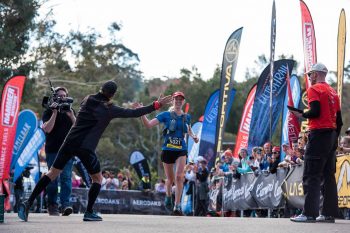
As is always the theme for these posts in the last few weeks to race day we focus on what are the most effective things you can do given the remaining time available.
In this post we’ll cover the last couple of weeks of conditioning, and tapering for Ultra-trail Australia
CONDITIONING FOR ‘DISCOMFORT’
What we know:
Training appears to be the mechanism by which we are able to improve our ability to tolerate pain (our ability to sense pain – ‘pain threshold’ – is unchanged by exercise).
Athletes have a higher tolerance for pain than ‘non-athletes’
Top performing athletes have a higher tolerance for pain than amateur athletes.
Elite/Professional athletes in periods of low-training or rest lower their ability to tolerate pain.
Elite/Professional athletes in periods of higher, more intense training improve their ability to tolerate pain.
PRACTICAL APPLICATION,
During the weeks leading into your target event carefully incorporate higher intensity efforts into your training to prepare yourself mentally for race day discomfort.
Progression runs / Rising Rate / Finish Fast
In some (not all) of your runs, consider ‘finishing fast’ by steadily rising intensity.
Nested Effort / Fartlek
Even in your longer runs, consider periods of elevated effort. Incorporate some 5 minute surges at >7/10 RPE in your long run or push hard up the hill in that long run.
Set aside a day to run a Fartlek session with 3 or 4 minute efforts with 2 minutes of jogged recovery.
MENTAL APPLICATION,
Throughout your training, prepare yourself mentally for the upcoming challenge. Take the time to imagine yourself going through the process of running or racing at Ultra-trail Australia such that you are conditioned to the expected stimulus on race day.
Imagine yourself at various places on the course,
What are you doing?
What can you see and hear?
How do you feel?
Mindfulness practices along the lines of the above will not only reduce anxiety and stress but help prepare the brain and establish comfort and ‘normality’ when these moments inevitably arrive.

TAPER TIME!
What we know:
NOT tapering accounts for around a 2-8% reduction in performance.
Optimal tapering for ultra-distance involves a three-week reduction in total volume.
“Collectively these data strongly support that overall aerobic function was at least maintained during the 3-wk taper”
“Overall this investigation provides a strong myocellular basis for distance runners, and athletes in general, to taper their training volume in preparation for peak performance. “
PRACTICAL APPLICATION,
Two easily applied methods appear to produce acceptable results for three week tapering,
1) Three weeks before race: Do 75 percent of normal “midseason” training. Eliminate virtually all “medium hard runs.” Do usual interval training.
Two weeks before race: Same as above.
Last week before race: Do 50 percent of normal training. Eliminate all medium hard runs. Do 50 percent of usual interval training. – Dr Scott Trappe.
2) Pin training intensities (eg maintain 80% easy / 20% hard) throughout the three week taper and reduce total volume by 20% per week.
Eg, Starting April 27th, remove 20% total volume.
Starting May 4th, remove 40% total volume.
Starting May 11th, remove 60% total volume.
Note that it is NORMAL to feel ‘out-of-sorts’ with this change to training load. Your body and mind is used to cycles of overload stress and adaptation. A reduction in this is unusual and it is common place for athletes to report feeling worse or becoming unwell in taper. This is an indication that your training was in fact working! Rest is when you get better. What better time to get better than in the weeks preceding your race!

